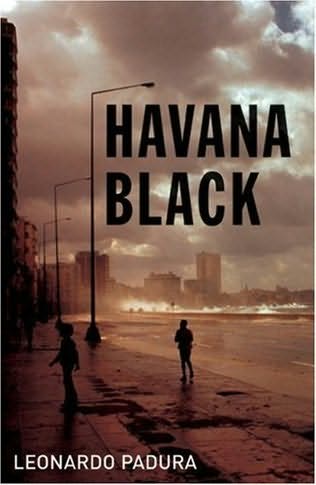Bitter Lemon Press 2006
translated from Spanish by Peter Bush
first published in Spanish 1998
ISBN 1-904738-12-X
261 pages
setting: Cuba
source: my local library
When the news comes through that his chief for the last eight years, Major Antonio Rangel, is to be replaced, as a result of investigations that require a scapegoat, Detective Lieutenant Mario Conde (the Count), a few days short of his 36th birthday, requests a discharge, and goes home to drown his sorrows in a bottle.
Havana is lying in wait for Hurricane Felix. Conde has been watching it's progress, convinced that despite it's meanderings Havana is the hurricane's target. Conde's new boss sends Sergeant Manuel Palacios to his home to bring him in. He has a proposition for him. Conde is being offered one last job, and then he will be allowed to leave smelling of roses. The new boss Colonel Molina is an officer from Military Intelligence and he knows little about police work but he knows he needs Conde to deal with the hot potato that has just arrived.
A man's corpse has been found. A Cuban with US citizenship who'd come to see his dying father. He'd been thrown into the sea after being battered by a baseball bat. His penis and testicles had been cut off after death with a blunt knife. In the 1960s he had been the deputy head of the Provincial Office for Expropriated Porperty, and in 1978 as national deputy director for Planning and the Economy he had made a trip to the Soviet Union, stopped off in Madrid on the way back, and defected to the USA. Since then he'd been living in Florida. So the big question was: why had he come back to Cuba?
Conde agrees that he will take on the case, that he will solve it in 3 days, and in return he wants to be able to consult his former boss Rangel, and to get a letter of discharge.
I didn't find HAVANA BLACK an easy read, possibly because it wasn't the first in the series and I wasn't already acquainted with Mario Conde. Initially I found the interchangeable use of Conde and Count confusing and thought there must be a second character. Then there were large sections of the book where I just wanted to get on with the story, and fast passage was halted by pages of unparagraphed text. There were long passages dredging up detail from Conde's past, descriptions of Havana, and Conde, who wants to be a writer in his next life, philosophising.
I was impatient for the initial question to be solved. Why did the dead man return to Havana when he must have known that, although twenty years had passed since his defection, his life could be in danger?
Well, we got there eventually and I breathed a sigh of relief. I read this as my 19th novel in the 2010 Global Reading Challenge, and yes I did learn something of life in Cuba.
My rating: 4.1
Learn more about Leonardo Padura and his Havana series on The Game's Afoot
Mario Conde Mystery (order of English publication - N.B. they were translated out of order)
1. Havana Red (2005)
2. Havana Black (2006)
3. Havana Blue (2007)
4. Havana Gold (2008)
5. Havana Fever (2009)

Kerrie - This does sound like a complicated plot and I probably would have wanted to get to the main point of the story, too. I may wait on this one...
ReplyDeleteI didn't find it a difficult read at all and it is the only one of Padura's books I've read. I thought it interesting that Padura, who lives in Cuba, does not paint a rosy picture of post-revolution Cuba. A bit cynical, in fact. I keep meaning to go back and pick up the rest of the series. I read it a while ago but remember enjoying the setting and the descriptions.
ReplyDelete